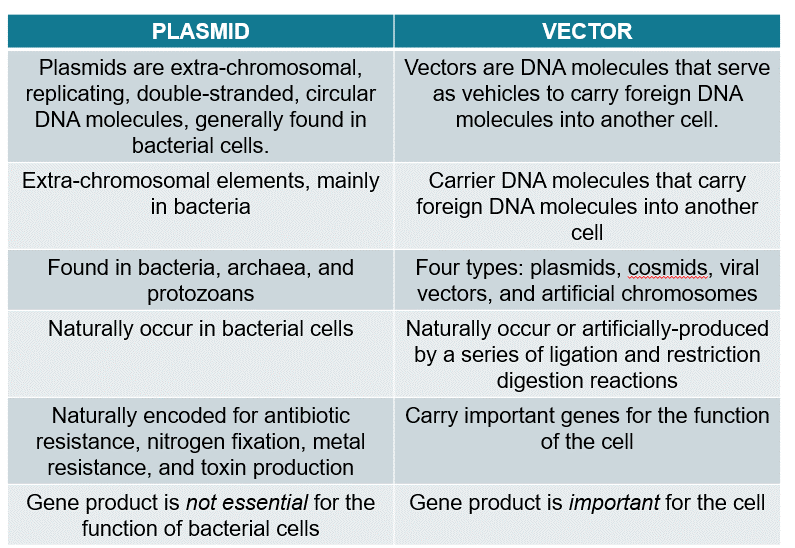Plasmids are small DNA molecules that exist in cells and can replicate independently in vitro. Their sizes range from 1 kb to 200 kb. Most plasmids from bacterial cells are double stranded, covalently closed, circular molecules in supercoiled form.
Classification of Plasmids
According to different classification criteria, plasmids can be divided into different categories. According to the transfer characteristics of plasmids, plasmids can be classified as conjugated or non-conjugated. According plasmid replication characteristics, plasmids can be classified as tight or relaxed. According to the phenotypic effect, E. coli plasmids can be classified by fertility factor, resistance factor, and colicin factor. Depending on whether plasmids can coexist in the same bacteria, they can be classified as compatible plasmids and incompatible plasmids. According to the genes carried by plasmids and the characteristics of host cells, plasmids can be classified as resistance plasmids, fertility factors, col plasmids, degradative plasmids, invasive plasmids, and cryptic plasmids.
Plasmid Vectors
The constructed plasmid can be used as a vector for genetic engineering. Compared with natural plasmids, plasmid vectors usually contain one or more selective marker genes (such as antibiotic resistance genes) and a synthetic polyclonal site sequence containing multiple restriction endonuclease recognition sites. Most of the non-essential sequences are removed to reduce the molecular weight as much as possible, in order to facilitate the genetic engineering operation. All plasmid vectors have three common components: a replicator, a selective marker, and a cloning site. Artificially constructed plasmid vectors are important tools in genetics and biotechnology laboratories and are usually used to clone, amplify (replicate), or express specific genes.

Plasmid Preparation Methods
Generally, the method of isolating plasmid DNA includes three steps: (1) Cultivating bacteria to amplify plasmid DNA; (2) Collection and lysis of bacteria; (3) Isolation and purification of plasmid DNA. There are many methods for isolation and preparation of plasmid DNA, including alkaline lysis, boiling lysis, SDS, and hydroxyapatite chromatography. In practice, different methods can be selected according to the type of host strain, plasmid molecular size, base composition and structure, as well as the use of the plasmid DNA. The most commonly used methods for plasmid preparation are alkaline lysis and boiling lysis.
Plasmid Preparation | Synbio Technologies
Synbio Technologies conducts comprehensive quality control of all our plasmid products to provide you with aseptic plasmids with no RNA pollution or genome pollution. All plasmids we manufacture are free of animal-derived materials and can contain low levels of endotoxin (< 100EU/mg, <30EU/mg, <5EU/mg) on request. According to customer’s different application needs, our standard plasmid DNA preparation services are divided into two levels: research level and transfection level. The plasmid DNA preparation process is designed to meet our customers’ diverse downstream applications such as transfection, antibody preparation, vaccine, and gene-therapy research, and more!
Experimental Procedure

Quality Control
Synbio Technologies’ plasmid preparation service focuses on quality. We have strict quality control which can increase stability and assure batch-to-batch consistency to satisfy our customers’ needs.
| Quality Control | Standard Range | Measurement Technique |
|---|---|---|
| Appearance | Clear, transparent | Visual inspection |
| A260/280 Analysis | 1.80~2.00 | UV spectrophotometer |
| Concentration | Up to 5mg/ml, default 1±0.05 mg/ml | UV spectrophotometer |
| Supercoil Percentage Analysis | >95% | Density scan on agarose gel |
| RNA Residue Analysis | Not detectable | Visual inspection on agarose gel |
| Genomic DNA Analysis | Not detectable | Visual inspection on agarose gel |
| Sterility Assurance | No clone growth on LB plate > 48h | Incubate 0.1mg of product on LB plate for >48h |
| Restriction Enzyme Analysis (optional) | As expected, no other minor band | Incubate with enzyme and analyze on agarose gel |
| Sequence Verification (optional) | Correct | DNA Sequencing |
| Endotoxin Analysis (optional) | <0.005EU/μg | Endotoxin Analysis Assay |
Reference
Lakna. Difference Between Plasmid and Vector. Molecular Biology. February 2, 2018.

